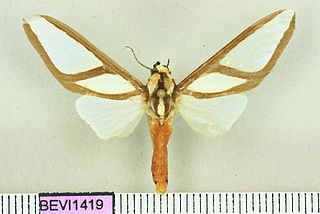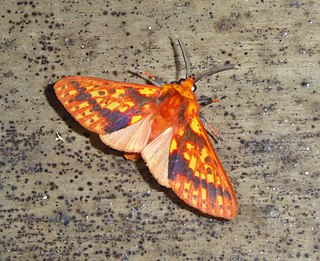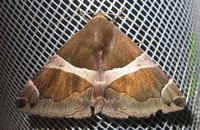
Omiodes is a moth genus in the family Crambidae. Several species are endemic to Hawaii.

Amata is a genus of tiger moths in the family Erebidae. The genus was erected by Johan Christian Fabricius in 1807.
Balacra is a genus of moths in the family Erebidae.
Hyponerita is a genus of moths in the family Erebidae erected by George Hampson in 1901.

Leucanopsis is a genus of moths in the family Erebidae. The genus was described by Alfredo Rei do Régo Barros in 1956.
Metalobosia is a genus of moths in the subfamily Arctiinae. The genus was erected by George Hampson in 1900.

Pseudapistosia is a genus of moths in the family Erebidae.

Robinsonia is a genus of moths in the family Erebidae. The genus was erected by Augustus Radcliffe Grote in 1866.

Symphlebia is a genus of moths in the family Erebidae. The genus was erected by Felder in 1874.
Aurotalis is a genus of moths of the family Crambidae.

Cnaphalocrocis is a genus of moths of the family Crambidae. The genus was described by Julius Lederer in 1863.
Diathraustodes is a genus of moths of the family Crambidae.

Eoophyla is a genus of moths of the family Crambidae. It was erected by Charles Swinhoe in 1900.
Erupa is a genus of moths of the family Crambidae.

Pyrausta is a speciose genus of moths of the family Crambidae. The genus was erected by Franz von Paula Schrank in 1802.

Dysgonia is a genus of moths in the family Erebidae. The genus was erected by Jacob Hübner in 1823.

Loxioda is a genus of moths of the family Erebidae. The genus was described by Warren in 1913.

Ancylosis is a genus of snout moth. It was described by Philipp Christoph Zeller in 1839, and is known from South Africa, Uzbekistan, Spain, Turkmenistan, Lebanon, Algeria, Tunisia, Russia, Israel, Palestine, Tinos, Australia, Seychelles, Afghanistan, the United States, Iraq, Namibia, Kazakhstan, Iran, Mauritius, Mozambique, Sarepta, Argentina, Sri Lanka, and Aden.









